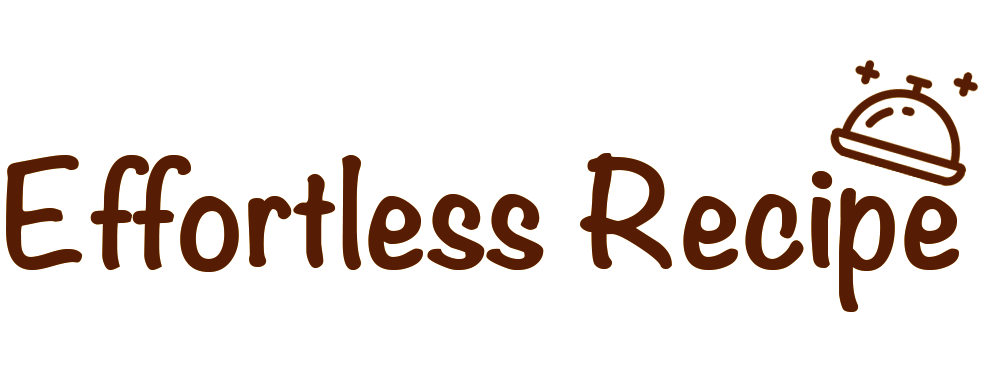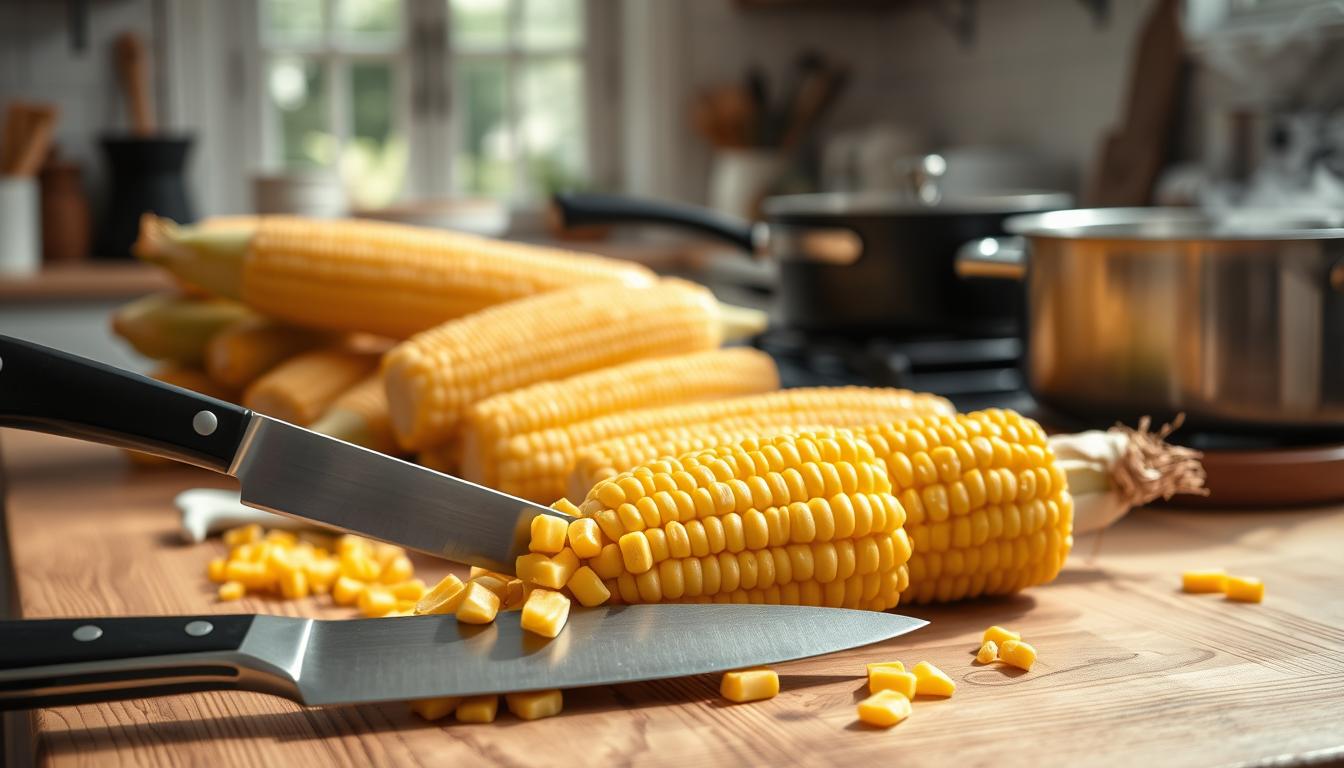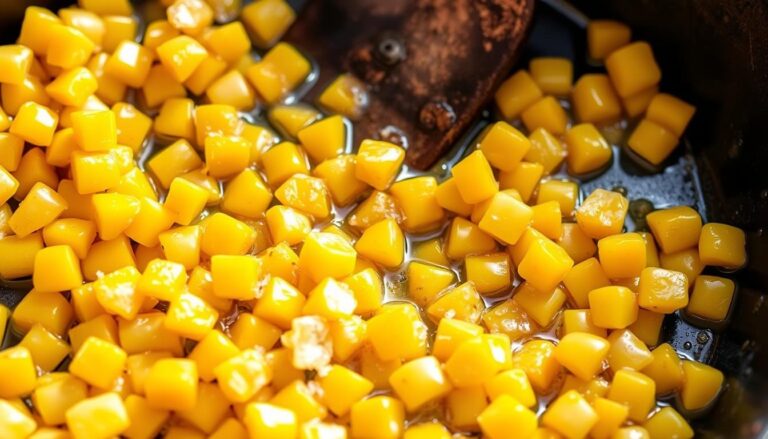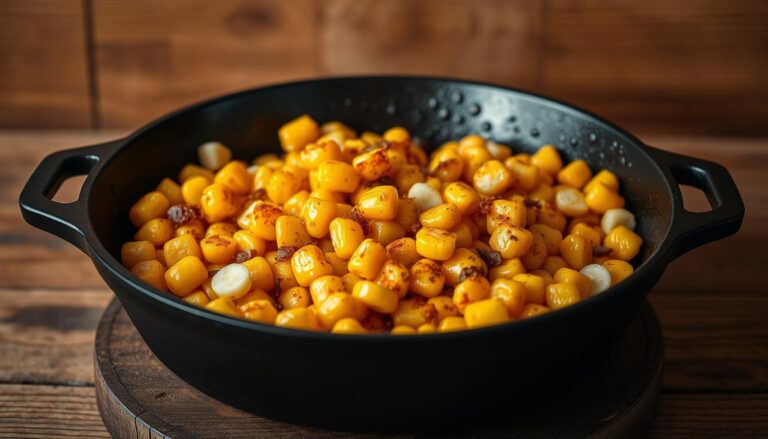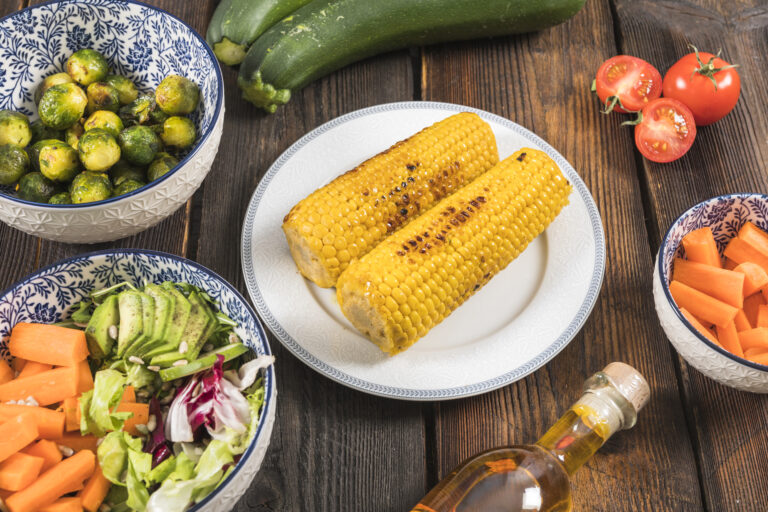Cooking Fresh Corn Off The Cob: Best Methods & Tips
Table of Contents
Summer brings a burst of golden sweetness to our tables. Nothing captures the season’s essence like fresh corn. As a home cook, I’ve found cooking fresh corn off the cob is an art form.
August is the peak season for corn. It’s the perfect time to master cooking fresh corn off the cob. Whether you’re busy or a weekend cooking enthusiast, learning how to cook corn can make your summer meals special.
This guide will teach you everything about selecting, preparing, and cooking fresh corn. You’ll learn how to choose the ripest ears and how to cut corn without making a mess. You’ll discover professional techniques that make corn preparation easy and fun.
There are many ways to cook corn, like grilling, roasting, and air frying. You’ll see how versatile this summer vegetable is. Get ready to learn how to turn fresh produce into delicious, crowd-pleasing dishes that celebrate summer.
Understanding Fresh Corn Selection and Storage
Choosing the right ears of corn is an art that can make your cooking better. Knowing how to pick and store corn is key to great flavor and enjoyment.
How to Choose the Best Sweet Corn
Start by looking closely at the corn. Here’s what to look for:
- Plump, milky kernels that go all the way to the tip
- Bright green, fresh-looking husks
- Moist, silky tassels that aren’t dry
- Kernels that feel firm when pressed gently
“Fresh corn is nature’s sweetest gift when picked at the perfect moment.”
Proper Storage Techniques
Keeping corn sweet is all about the right storage. Traditional sweet corn turns sugars into starch fast after it’s picked. Here are some tips:
- Store corn in the fridge’s crisper drawer
- Keep it in its original husk
- Eat it within 3 days for the best taste
- Keep it damp by wrapping in moist paper towels
Peak Season Timing
For the tastiest corn, timing is key. Sweet corn is at its best from late summer to early September. Local farmers markets often have the freshest corn, picked just hours before.
Pro tip: Commercial corn stays sweet for 5-6 days. But farm-fresh corn is best eaten within 1-2 days.
Essential Tools and Equipment for Corn Preparation
Having the right tools can make cooking fresh corn off the cob a breeze. Both professional chefs and home cooks know that the right equipment makes vegetable side dishes easier to prepare.
Your essential corn preparation toolkit should include:
- Sharp Chef’s Knife: A sturdy blade for precise cutting
- Cutting Board: Preferably wooden or plastic with good grip
- Corn Stripper: Optional but helpful specialized tool
- Large Bowl: Catching kernels during cutting
- Kitchen Towels: For cleanup and handling
Choosing high-quality tools is key for safety and efficiency in corn preparation. A professional-grade chef’s knife offers stability and control, making it easier to remove kernels from the cob.
| Tool | Purpose | Recommended Material |
|---|---|---|
| Chef’s Knife | Kernel Removal | High-carbon stainless steel |
| Cutting Board | Safe Surface | Hardwood or food-grade plastic |
| Corn Stripper | Efficient Kernel Extraction | Stainless steel with ergonomic handle |
Pro tip: Always keep your tools clean and sharp. A dull knife can make cooking fresh corn off the cob more challenging and potentially dangerous.
Husking and Cleaning Fresh Corn
Getting fresh corn ready for cooking starts with husking and cleaning. Husking is key to enjoying a tasty and healthy meal. It might seem hard, but learning to shuck corn is easy with the right steps.
Choose corn with bright green, moist husks and plump kernels. Corn from local markets or Iowa’s fields tastes the best.
Efficient Silk Removal Techniques
Removing corn silk can be a challenge. But these tips will make it easy:
- Gently pull back the husks section by section
- Use a stiff vegetable brush to remove remaining silk strands
- Rinse the corn under cool water to wash away loose silk
- Pro tip: A clean, damp paper towel can also help remove stubborn silk
Pre-Cooking Preparation Steps
Before cooking, follow these steps to get your corn ready:
- Inspect each ear for any blemishes or damaged kernels
- Trim the ends of the corn if needed
- Rinse thoroughly under cold water
- Pat dry with a clean kitchen towel
Fresh corn is best used within 1-2 days of purchase to maintain optimal sweetness and flavor.
Mastering these husking techniques will help you make tasty corn dishes. You’ll enjoy the natural sweetness of this versatile veggie.
Cooking Fresh Corn Off the Cob: Basic Methods

Learning to cook fresh corn off the cob opens up a world of tasty recipes. Whether it’s a summer side dish or a main course, knowing how to cook it makes a big difference. It boosts your cooking skills.
Here are the main ways to cook fresh corn off the cob:
- Boiling: The quickest and most straightforward method
- Sautéing: Adds rich, caramelized flavor
- Grilled corn: Brings out smoky, intense taste
- Oven-roasting: Provides even, consistent cooking
To boil corn perfectly, start by boiling salted water. Add 2 cups of cut corn and cook for about 4 minutes. Pro tip: Fresh corn should ideally be cooked within one day of picking to maintain maximum sweetness.
| Cooking Method | Time | Flavor Profile |
|---|---|---|
| Boiling | 4 minutes | Classic, sweet |
| Sautéing | 5-7 minutes | Caramelized, rich |
| Grilling | 40-60 minutes | Smoky, intense |
“The key to great corn is fresh ingredients and careful cooking,” says April Robertson, a culinary expert specializing in seasonal produce.
Grilled corn is a great choice for outdoor cooking. Mike Buis, an experienced farmer, suggests grilling for 40-60 minutes. Turn the corn four times to cook evenly and bring out the best flavor.
Remember, one ear of corn gives about ½ cup when cut off the cob. These cooking methods will help you make delicious dishes that highlight the natural sweetness of fresh corn.
The Bundt Pan Method: A Game-Changing Technique
Cooking fresh corn off the cob can be messy. But, the Bundt pan method is a clever solution. It makes removing corn kernels easy and keeps your kitchen clean.
“A smart kitchen hack is worth its weight in gold” – Culinary Wisdom
Both professional chefs and home cooks love this method. It uses a Bundt pan to remove kernels in a smart way. This makes cooking vegetable side dishes a breeze.
Why the Bundt Pan Works Perfectly
- Creates a stable cutting surface
- Catches kernels in the pan’s base
- Reduces flying kernels
- Minimizes kitchen mess
Step-by-Step Cutting Process
- Select a clean Bundt pan
- Position corn cob’s tip in the center tube
- Hold corn vertically
- Use a sharp knife to slice downward
- Rotate corn to remove all kernels
Chef Ina Garten suggests this method. It’s effective. Stand the cob upright and cut down carefully to collect kernels efficiently.
| Method | Mess Level | Ease of Use |
|---|---|---|
| Traditional Cutting | High | Moderate |
| Bundt Pan Method | Low | High |
Pro tip: Make sure your knife is sharp for clean cuts. A dull knife can crush kernels instead of cutting them off cleanly.
Best Temperature Control for Perfect Corn
Learning to cook fresh corn off the cob is all about temperature control. The right heat turns regular corn into a tasty, healthy treat. It keeps its natural sweetness and texture just right.
Temperature is key in cooking corn. Each method needs a specific heat to get the best results:
- Boiling: Aim for water temperature around 180°F
- Steaming: Maintain heat between 3-4 minutes
- Roasting: Preheat oven to 400°F
Studies show that cooking corn for 3-4 minutes stops it from getting shriveled. The cold-start method, where corn and water are heated together, makes kernels plump. This method cooks evenly and keeps the corn’s flavor.
Important temperature tips for cooking fresh corn include:
- Water temperature reaches 180°F after 10 minutes
- Steaming works best at 3-4 minute intervals
- Microwaving requires 2-3 minutes per ear
By mastering temperature control, you can make your corn dishes amazing. Each method has its own benefits. Try different ways to find the best way to cook healthy, tasty corn.
Preserving and Freezing Cut Corn
Seasonal cooking brings joy to home kitchens. Preserving fresh corn lets you enjoy summer’s bounty all year. With the right techniques, you can keep peak flavor and nutrition for months.
Freezing corn is a great way to keep it fresh longer. From one harvest, you can save over 150 pints of sweet corn. A five-gallon bucket of unhusked corn usually gives about 7 pints of cut corn for freezing.
Blanching Guidelines
Blanching is key to keeping corn’s quality. Here’s how to do it:
- Boil water for 5 minutes
- Submerge corn kernels for 5-6 minutes
- Immediately transfer to an ice water bath
- Ensure corn is completely dry before packaging
Storage Tips and Duration
Proper storage keeps your corn tasty:
- Use freezer-safe bags or containers
- Remove excess air before sealing
- Label bags with contents and date
- Store in single layers initially
Pro tip: Frozen corn can be stored in a deep freezer for up to one year without losing quality. When you’re ready to use your preserved corn, it’s perfect for casseroles, pasta dishes, and other recipes that require reheating.
By following these preservation techniques, your seasonal cooking can last beyond summer. You’ll enjoy the sweet taste of fresh corn all year.
Creative Ways to Use Fresh Cut Corn
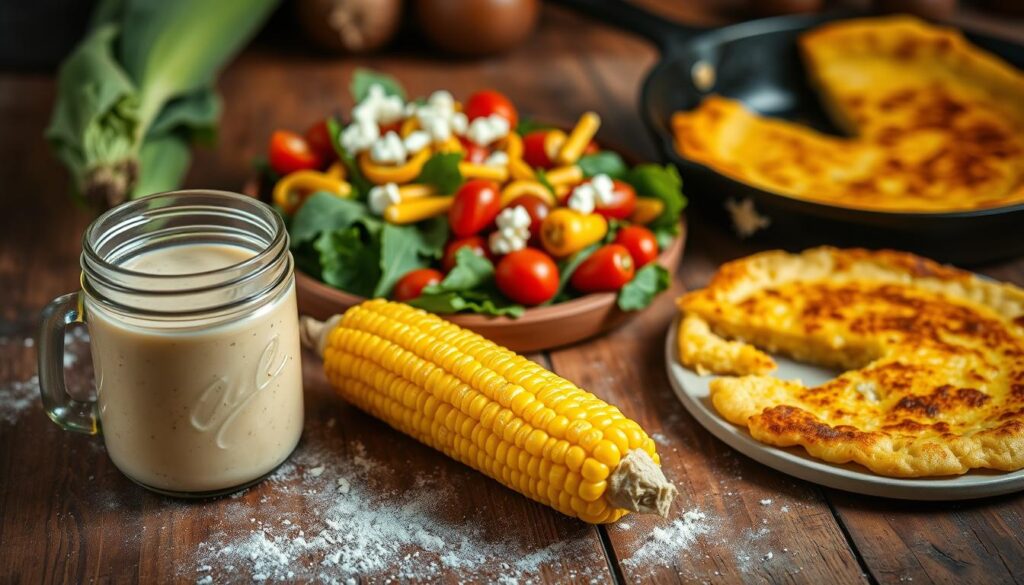
Fresh cut corn is a treasure trove for tasty recipes and side dishes. It lets you get creative in the kitchen. You can turn these sweet kernels into dishes that are both healthy and full of flavor.
Here are some fun ways to use fresh corn in your cooking:
- Summer Sweet Corn Sauté: A quick and nutritious side dish
- Fresh Corn Salad: Packed with vibrant ingredients
- Corn Quesadillas: A crowd-pleasing appetizer
- Corn Fritter Waffles: A unique breakfast option
If you’re looking for healthy options, fresh corn is a great choice. It’s packed with nutrients. Let’s look at some nutritional facts of corn-based dishes:
| Dish | Calories | Protein (g) | Carbs (g) |
|---|---|---|---|
| Summer Sweet Corn Sauté | 122 | 2 | 12 |
| Fresh Corn Salad | 371 | 23 | 25 |
| Corn Quesadillas | 380 | 16 | 36 |
Pro tip: Try adding herbs like basil, dill, or cilantro to your corn dishes. They add a burst of flavor. Whether you’re making a simple side or a big meal, fresh corn is a great ingredient to have.
Nutritional Benefits of Fresh Corn
Fresh produce like summer vegetables are great for healthy eating. Corn is a standout, packed with essential nutrients in every kernel.
Let’s look at the nutritional profile of fresh corn:
- One-half cup of corn has about 85 calories
- It has 3 grams of protein per serving
- It offers 2-3 grams of dietary fiber
- It’s rich in B vitamins, like thiamin
Corn is more than a tasty summer veggie. It’s good for your eyes thanks to lutein and zeaxanthin. These antioxidants protect your vision and may lower eye disease risk.
The fiber in corn helps your digestion and keeps blood sugar steady. As a low-glycemic food, it gives you energy without sudden blood sugar spikes.
A 2022 review in Nutrients showed corn’s benefits for wellness and reducing chronic disease risks.
Adding fresh corn to your meals means you’re choosing a nutrient-rich food. It’s part of a balanced diet. Cook it healthily, like steaming or boiling, to get the most nutritional benefits.
Conclusion
Learning to cook fresh corn off the cob is exciting. It opens up a world of flavors during summer. You’ll find that simple corn kernels can become delicious dishes that highlight the season.
There are many ways to cook corn, like grilling or using a Bundt pan. Each method brings out the best flavor. It’s important to eat corn quickly because it loses its sweetness fast. An ear of corn can give you 1/2 to 1 cup of kernels, perfect for many recipes.
Trying out different ways to prepare corn can make your cooking better. You can make everything from nachos to cornbread. Knowing how to pick, clean, and cook corn will make your dishes taste amazing. Get creative with corn in your kitchen this summer.
Now you know how to cook fresh corn off the cob. This skill will impress everyone. It turns simple meals into special moments that celebrate the sweetness of summer corn.
Must-Have Kitchen Tools
- Cast Iron Skillet – Retains heat evenly and helps caramelize the corn beautifully.
- Sharp Chef’s Knife – Ideal for cutting fresh corn off the cob cleanly.
- Cutting Board – Provides a stable surface for slicing and preparing ingredients.
- Corn Stripper (Optional) – Speeds up the process of removing kernels from the cob.
- Wooden Spoon or Silicone Spatula – Helps stir the corn without damaging your skillet.
- Digital Meat Thermometer – Ensures precise cooking temperature for the best texture.
- Mixing Bowls – Useful for collecting corn kernels and mixing seasonings.
- Measuring Spoons & Cups – Helps get the perfect butter, salt, and seasoning ratio.
Check this for more recipes about cooking fresh corn off the cob
